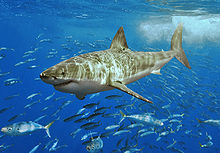- Gigantothermy
-
 The great white shark, Carcharodon carcharias, exhibits gigantothermy
The great white shark, Carcharodon carcharias, exhibits gigantothermy
Gigantothermy (sometimes called ectothermic homeothermy) is a phenomenon with significance in biology and paleontology, whereby large, bulky ectothermic animals are more easily able to maintain a constant, relatively high body temperature than smaller animals by virtue of their smaller surface area to volume ratio.[1] A bigger animal has proportionately less of its body close to the outside environment than a smaller animal of otherwise similar shape, and so it gains heat from, or loses heat to, the environment much more slowly.[2]
The phenomenon is important in the biology of ectothermic megafauna, such as large turtles (particularly the leatherback sea turtle), and aquatic reptiles like ichthyosaurs and mosasaurs. It is also present in certain large fish, most notably the great white shark. Gigantotherms, though almost always ectothermic, generally have a body temperature similar to that of endotherms.[citation needed] It has been suggested that the larger dinosaurs would have been gigantothermic, rendering them virtually homeotherm.[3]
See also
Notes
External links
Thermoregulation in animals Ectothermy · Endothermy Poikilothermy · Heterothermy · Homeothermy (Gigantothermy)Kleptothermy · Bradymetabolism · Tachymetabolism
Poikilothermy · Heterothermy · Homeothermy (Gigantothermy)Kleptothermy · Bradymetabolism · TachymetabolismThis animal physiology-related article is a stub. You can help Wikipedia by expanding it.
